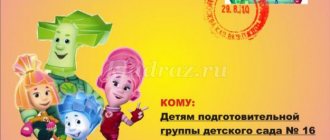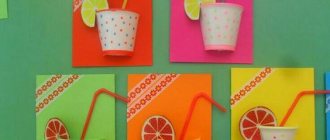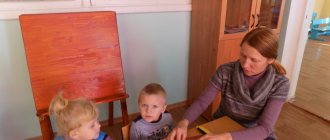Kitten Woof
As part of the next instruction, we will try to consider in detail how to make a cat known to all children named Woof. To prevent this kind of plasticine modeling for 3- and 4-year-old children from seeming boring, watch your favorite Soviet cartoon with this cat before class.
When you are ready for the sculpting process, start selecting the material. What you will need:
- plasticine in the required proportions;
- stack for obtaining the necessary parts and giving them the required shape;
- a wooden board or sheet of paper to protect the work surface.
Before starting, be sure to warm up and knead the material so that it is easier for your child to work with it. How to make a cat Woof from plasticine:
(Step 1)
- Take a light brown or orange shade of plasticine and roll it into a ball. We flatten the resulting figure by carefully pressing it to the working plane. We get an oval from the ball.
- Now you need a shade slightly darker than the previous one. We make a cake out of it. We attach the resulting workpiece to the previously obtained oval.
- Roll out a ball from the same dark color. It is needed for the animal's face. Trim the edges of the figure and smooth the joints to eliminate any visible seams.
Kitten Woof (Step 2) - We continue to design the cat's face. We make a spout on the sharp part. We form the cat's ears; they should have a triangular shape. We attach them to the head. We make the eyes using light brown pancakes. The middle of them can be made black. Add blue details and white droplets to the black background to highlight the eyes. Attach the made eyes to their proper place.
- In order for our kitten to sit, we make something like a cushion out of light brown material. Gently flatten one side to form a flat surface. On the contrary, we make the second side pointed in order to attach it to the head in the future.
- Let's finish the job. We carefully draw the fingers on the animal’s paws. Forming the cat's tail.
- Attach the torso to the head. For a more secure attachment to the body, you can insert the list and place the head on the protruding edge. Attach the tail made earlier to the cat.
The work is ready, you have learned how to make a cartoon cat from plasticine. The pet turned out to be charming and is unlikely to leave a child or an adult indifferent. And if you use your imagination and remember the plot of the cartoon, then the kitten needs to finish the cutlet so that he eats it. You can place such a toy in your collection of crafts, for example, next to a plasticine hedgehog.
One balloon kitten
If you are considering the topic of plasticine crafts for children and are looking for something simple but beautiful, then the next cat is for you. This character is funny, well-fed and very cute.
Making such a fat cat is very simple, for this:
- Preparing plasticine for work. Choose any shade you like. Heat the material and roll it into a ball. The main figure can be any size. Do you want to get the most well-fed cat? Make a very large ball.
(Step 1) - Additionally, roll a few more balls. We form ovals from the obtained parts. We attach it to the body. Pay attention to the photo of the cat; the hind legs should be slightly larger than the front ones.
(Step 2) - We complement the main figure with a tail. The presentability of our fat man will depend on the length. Roll out the worm, attach it to the ball and wrap the end. Entrust this work to your child, because these plasticine crafts for children are very simple.
(Step 3) - Forming the ears. Roll two small balls or one large one and flatten the workpiece. Cut out the triangles. Carefully attach the finished triangles to the ball and slightly turn the ears at the end inward for volume.
We figured out how to mold the base of a cat from plasticine; it needs to be supplemented with small elements so that a certain facial expression appears.
Follow these steps:
- We continue to work with the main color. Let's make two peas. They will become cheeks. We attach them to the muzzle and carefully smooth them out.
- To make the cat have the same facial expression as in the photo, make a third ball and place it below the cheeks.
- Let's make a nose. Choose a color. Of course, pink will look cutest. Roll the ball and secure it in place.
- Now you need to make the eyes. Wash your hands before handling them, because you will have to work with white. Dirty hands may leave marks on the material.
- Roll out two white peas. We attach the pupils to them; it is not necessary to use plasticine as the pupil, you can place beads of the color you need here.
- We can't leave our furry pet without a mustache. To make them you can use white thread or fishing line. Gently insert the mustache into your cheeks.
- We complete the creation of the cat. Use small white triangles to make fangs for the cat. Draw the animal’s fingers, holes on its nose and cheeks.
Look, we learned how to mold a well-fed cat from plasticine! This toy is ideal for any children. If you want to keep this plump cat company, you can choose a friend for him from the article on how to make animals from plasticine.
Preview:
. Summary of educational activities for modeling for children of primary preschool age “Kitten”
The purpose of the GCD: to teach children to sculpt a four-legged animal - a cat.
Tasks: to consolidate sculpting techniques: rolling plasticine between the palms; consolidate the ability to connect parts, pressing them tightly against each other. Develop independence. Cultivate accuracy when working with plasticine.
Preliminary work: conversations with children about pets, looking at illustrations, reading fiction and educational literature, riddles, didactic games: “Who lives where?”, “Where is whose cub?”, “Find out by description.”
Materials: plasticine on boards (for each child) and separately on plates, stacks, oilcloths, boards, a modeling support diagram with an image (a kitten, a magnetic board, a layout with multi-colored balls, a disk with background music for the practical part.
Let's say "Hello!" each other.
Hi all!" and “Good afternoon!”;
Q: Guys, look, guests have come to us. Let's say hello to them. D: Good morning!
Q: Guys, come to me, please. Look what we have on the table?
Q: What kind of pet do you think likes to play with balls?
Q: Look how many glomeruli there are, are they the same? What color and shape are they?
D: red, yellow, etc. multi-colored, round.
Q: Guys, there are balls, but there is no one to play with them. What can we do?
Q: Let's make kittens so they can play with them.
Q: And in order for your ears to listen to me carefully, and your eyes to see what I’m going to show, let’s play with you.
Wash your cheeks with your paw (act in accordance with the text)
Right eye left eye
Q: After being kittens, we turn into guys and sit down in our seats. We sit down straight, backs straight, eyes on me.
Q: And now I’ll show you how to make a kitten.
Here I have a large piece of plasticine. I tear off a smaller piece - this will be the head of our kitten. Now I tear off an even smaller piece from a larger piece - this will be the tail of our kitten. And from this remaining piece of plasticine I will sculpt the body of our kitten. I will roll this piece of plasticine into a sausage. Then I take the stack and make longitudinal cuts on both sides of this sausage. These will be our kitten's paws. Now we take a piece from which I will roll a ball - this will be the head of our kitten. The ball can be rolled between straight palms or between the palm and the table.
We flatten the plasticine on both sides of the ball with two fingers (thumb and index) and we will get ears. Let's take buckwheat grains and make eyes, take a very small piece of black plasticine, roll a small ball between our fingers - this will be the kitten's nose. Then we take pieces of wire and attach whiskers to our kitten on both sides. Now we press the head to the body. There is a small piece of plasticine left, from which we will roll out a small sausage - this will be the kitten’s tail. We attach it to the body. Look what a wonderful kitten I got.
Finger gymnastics: “Kittens”
(We fold our palms, press our fingers together)
Our cat has ten kittens,
(We shake our hands without separating them)
Now all the kittens are in pairs:
(Tap the corresponding fingers against each other from the big to the little finger) Calm music sounds. Children make their own pet.
Self-analysis NOD: throughout the entire NOD maintained the children's interest in the result. Each child was actively involved in activities throughout the entire NOD. The children tried to use plasticine carefully.
Source
"Gifts for a kitten." Summary of GCD for modeling in the second junior group
Anna Maksimova
"Gifts for a kitten."
Abstract of GCD on modeling in the second junior group “ Gifts for a kitten ” Summary of GCD in the educational field “Artistic creativity” (
modeling ) in
the second junior group .
Topic: " Gifts for a kitten ."
Goal: Learn to sculpt plasticine balls.
Objectives: To introduce domestic animals and their babies, to develop the skill of word formation of nouns denoting baby animals; to cultivate a love for pets and a desire to take care of them, a kind attitude towards animals; learn to use acquired skills.
Materials and equipment: soft toys (cat and kitten , U balls, modeling , plasticine.
A simple sitting cat made of plasticine
The following instructions will tell you how to make a cat out of plasticine using simple steps. Despite the simplicity of execution, the finished product is surprisingly beautiful.
The first thing we will start with is choosing the color of the future animal. If you want a bright fluffy look, go for an orange shade. Fans of mystical murkas can choose black.
The list of materials for work does not change. We use a knife to separate the material into pieces and a board to protect the work surface. Now we’ll tell you how to make a cat from plasticine:
- Before you begin the main modeling, the material needs to be prepared for work. We warm it and knead it in our hands until it becomes completely pliable.
- Take the main color you chose for the cat and roll it into a ball. The finished figure needs to be given a conical shape. As a result, you should get the body of the future cat.
(Step 1) - We continue working with the main color. Make a big pea out of it. It is needed to make the head.
- Now we roll a thin worm. This is a wonderful tail. To make it look elegant, round it and sharpen it at the end.
- Decorate your cat with a beautiful bib. Roll into a ball, roll it out flat and cut out the bib. Make teeth along the edges so that the element looks like wool.
(Step 2) - To give the muzzle a natural look, you need to make four white peas. From these we will make the cat's eyes. We attach pupils of a different color to them, for example, black. We need the remaining white parts for the muzzle.
- Don't forget your nose. It can be made pink or orange. Give your nose a triangle shape for a more natural look.
(Step 3) - Let's take care of the ears. They need to be made in the form of thin triangles. You can make them from a color other than the main one. And, for example, from white. Inside each figurine we make we place an identical one, only with a smaller size and a different color.
- We finish working with the cat. We add dimples to his pupils, draw a mustache and toes.
The cat is ready. This plasticine modeling for children aged 3-4 years, like the previous one, is not complicated and interesting. All actions are elementary and with the help of adults, the cat will turn out natural and cheerful.
You learned how to make a cat from plasticine. Next, we will consider even more interesting manufacturing options.







